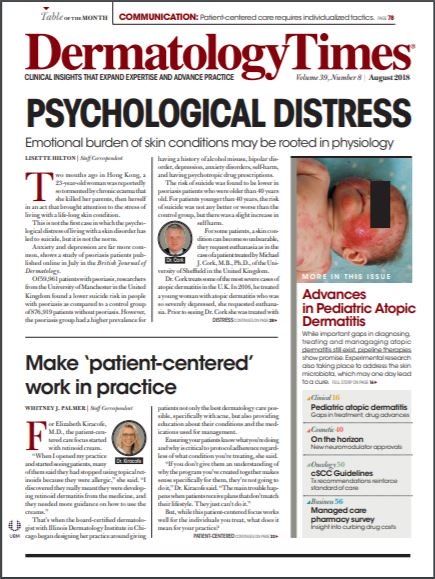- Acne
- Actinic Keratosis
- Aesthetics
- Alopecia
- Atopic Dermatitis
- Buy-and-Bill
- COVID-19
- Case-Based Roundtable
- Chronic Hand Eczema
- Chronic Spontaneous Urticaria
- Drug Watch
- Eczema
- General Dermatology
- Hidradenitis Suppurativa
- Melasma
- NP and PA
- Pediatric Dermatology
- Pigmentary Disorders
- Practice Management
- Precision Medicine and Biologics
- Prurigo Nodularis
- Psoriasis
- Psoriatic Arthritis
- Rare Disease
- Rosacea
- Skin Cancer
- Vitiligo
- Wound Care
Publication
Article
Dermatology Times
Study confirms oral propranolol safety for infantile hemangioma
Author(s):
Oral propranolol may be safe for infants with uncomplicated hemangiomas, but for those with underlying health conditions, it may not always be the treatment of choice.
A French study adds to the evidence that oral propranolol is a relatively safe treatment for infantile hemangioma. However, it may be associated with an increased risk for respiratory events and cardiovascular events in children, French researchers wrote in the June issue of Pediatrics.
Researchers, who led by Catherine Droitcourt, M.D., of Pontchaillou Hospital in Rennes, France, found that oral propranolol for infantile hemangioma was “good.” This is a treatment that has long been used for infantile hemangioma, but in 2008, French researchers documented the occurrence of some complications. After more testing, the treatment was eventually approved in 2014 by the European Medicines Agency for use in infantile hemangioma.
The new analysis is based on a large nationwide claims database of 1,484 children (three years or younger) with infantile hemangioma, but without underlying disease. And, 269 children with infantile hemangioma, but with underlying disease, such as cardiovascular, respiratory and metabolic conditions.
The patients received at least two deliveries of oral propranolol between July 2014 and June 2016 and the outcomes were generally favorable. In infantile hemangioma patients who did not have other health conditions, there were two cardiovascular, 51 respiratory (38 were hospitalized with bronchiolitis) and three metabolic events. But among children with underlying conditions who received the same oral propranolol treatment, there were 11 cardiovascular events - primarily, in children with pre-existing congenital heart disease. In 49 children with underlying respiratory disease, there were 11 respiratory events. No children with underlying metabolic disease experienced a metabolic event during treatment.
"The absence of risk for cardiovascular outcomes in the healthy population is reassuring. However, [in patients with underlying health conditions] much concern has been raised about cardiovascular effects and, more precisely, conduction disturbances, bradycardia, and hypotension," the authors wrote.
While acute respiratory disease is a well-identified risk in children treated with propranolol, the high number of cases in the infantile hemangioma-only group was concerning, the authors wrote, but the high rate of occurrence may be due to better monitoring and not necessarily more severe disease.
In terms of hospitalizations for metabolic events, this affected four patients in the infantile hemangioma-only group in which the patients developed hypoglycemia. Treatment was discontinued for three patients.
The authors do not suggest the need for monitoring oral propranolol outcomes for infantile hemangioma, but they do recommend some precautions. “Avoidance is advised in cases of lower
respiratory infection or low food intake. During the titration phase, a cardiovascular monitoring based on clinical parameters is recommended.”
REFERENCE
Droitcourt C, Kerbrat S, Rault C, et al. “Safety of Oral Propranolol for Infantile Hemangioma.” Pediatrics. Jun 2018, 141 (6). DOI: 10.1542/peds.2017-3783.

Newsletter
Like what you’re reading? Subscribe to Dermatology Times for weekly updates on therapies, innovations, and real-world practice tips.




























